Apple iPad mini with Retina Display: Reviewed
by Anand Lal Shimpi on November 16, 2013 8:00 AM ESTThe SoC
The iPad mini with Retina Display rounds out the three platforms that use Apple’s A7 SoC. Although both the iPad Air and iPhone 5S use the A7, the mini’s implementation is closer in nature to the iPhone. The iPad mini’s SoC has always used the same package-on-package (PoP) assembly as the iPhone, with DRAM stacked on top of the SoC itself (1GB in this case). The benefit is obviously a reduction in board area, the downsides have to do with cost and thermals. That’s the first similarity between the mini’s A7 and the iPhone’s A7.
The second is one of frequencies. While the iPad Air’s A7 runs its two Cyclone CPU cores at up to 1.4GHz, the SoC in the iPad mini and the iPhone 5S runs at up to 1.3GHz. That might sound like a minor difference, but it’s far more pronounced when you look at what happens to frequency when you’re running heavy workloads.
Once again I turn to a fairly heavy CPU workload to plot performance over time. This is a multithreaded workload, slightly modified from what we used in the iPad Air review, designed to make the CPU cores consume max power. The scale is linear and the workload is the same across all devices, so what you’re effectively looking at is a graph of thermally bound CPU performance over time across all three A7 implementations:
Being the largest device (and the only device with a metal heat spreader and no DRAM stacked on top), the iPad Air obviously maintains the highest frequencies for the duration of the test. The iPhone 5S, with a significant reduction in internal volume (and a PoP SoC) reduces its CPU frequencies early on in order to keep skin temperature down and properly manage thermals. The iPad mini with Retina Display falls between the two, with its performance curve more closely following that of the iPhone 5S.
Although the mini has a similar max operating frequency to the iPhone 5S, it is a faster device thanks to it being less thermally constrained. Similarly, the iPad Air can be much faster than its clock speed would otherwise imply. If you’re wondering why Apple has been so focused on building its own SoCs and CPU architectures, this is the reason why. There’s a fixed amount of power you can dissipate in the form of heat in these mobile devices while still maintaining a good user experience. Performance per watt is the gating metric for success in mobile, and shipping high IPC/low frequency dual-core SoCs at 32/28nm is the best optimization available to a company like Apple today.
As you’d expect, our browser based CPU tests show the mini’s A7 performing in between the iPhone 5S and iPad Air. None of these tests are anywhere near as stressful as our thermal test from above, so we don’t see exaggerated differences in performance between the platforms. For most, I suspect you won’t notice a huge performance difference between the mini and Air. Those who are heavier users (e.g. audio mixing, 3D gaming, etc…), there will be a performance difference between the two iPads.
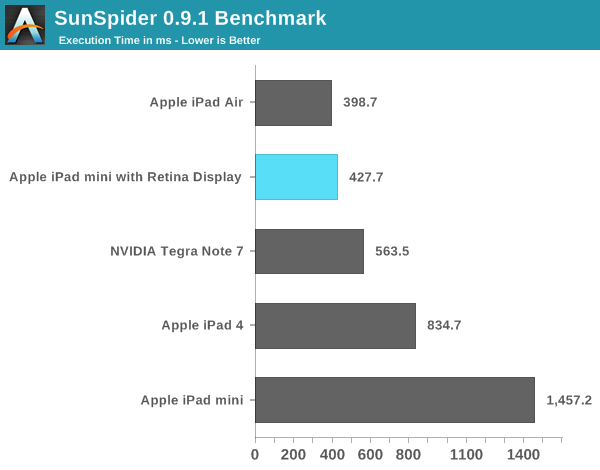

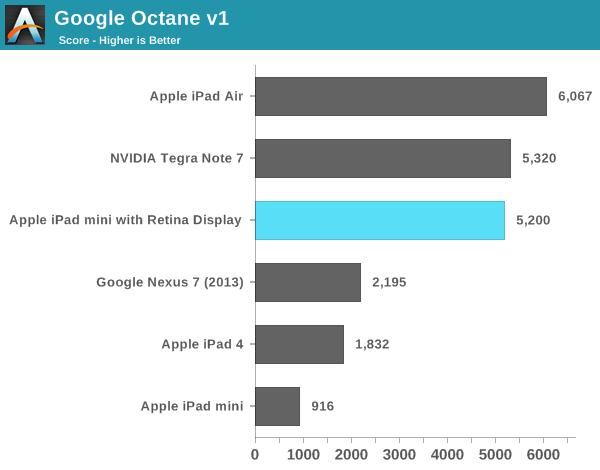
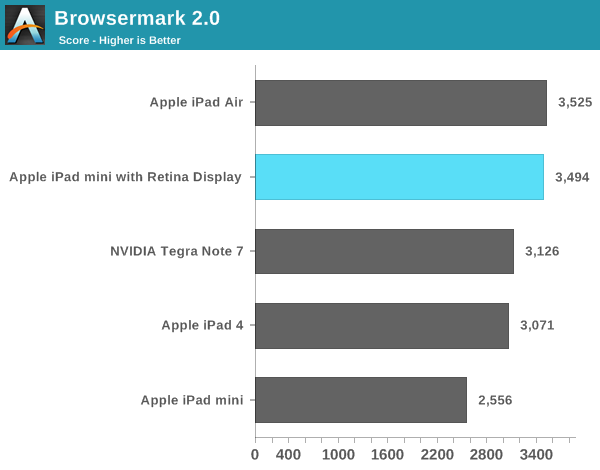
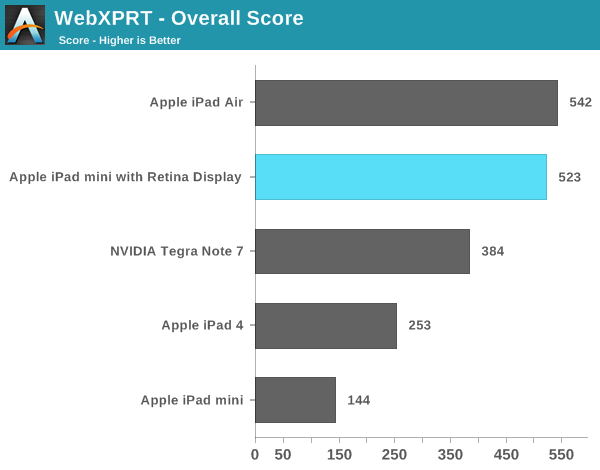
Compared to the first generation iPad mini, the new model is in a completely different performance league. Keep in mind the first mini used Apple’s A5 SoC based on an ARM Cortex A9. That’s the same single threaded performance as what’s in an iPhone 4S, and under iOS 7 it’s clearly running into some performance limits. The new mini with Retina Display however is a completely different animal. It’s fast.
Even comparing to the 4th generation iPad, the new mini is noticeably quicker.
Memory Bandwidth
Looking at the iPad mini’s memory bandwidth curve, we see it tracks very closely with that of the iPhone 5S. This is a slightly modified version of our previous bandwidth test, and you can see peak usable memory bandwidth (from the CPU’s perspective) of around 10GB/s. The ~12GB/s area right before you get out to main memory is bandwidth to the A7’s 4MB system-wide cache that sits after the shared L2 and the memory controller. This cache appears to service CPU, GPU and ISP requests at least.
GPU Performance
I believe the A7’s PowerVR G6430 GPU runs at around 450MHz. This frequency appears unchanged across all three A7 implementations. Once again, the big difference is how much thermal headroom exists in the platform which has an impact on overall performance.
Kishonti’s low level GPU performance tests back up my assertion that GPU frequency is fixed across all A7s. The iPad mini with Retina Display delivers equal performance to the iPad Air. The bigger news here is that nearly all of the GPU bound 3D tests seems to peg the mini and Air as equals. These are some pretty intense tests, but it looks like on the GPU side there’s no significant throttling when running at full tilt.
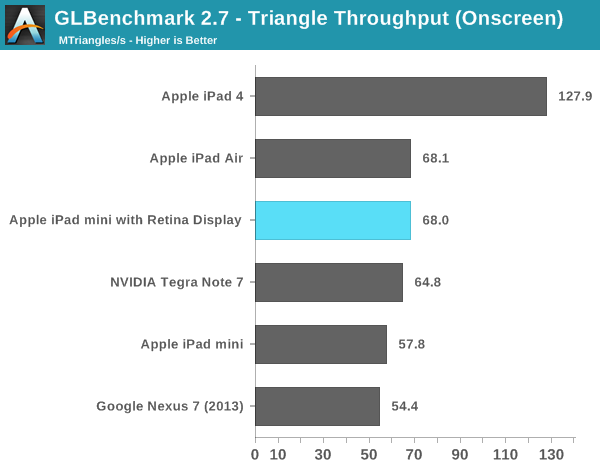

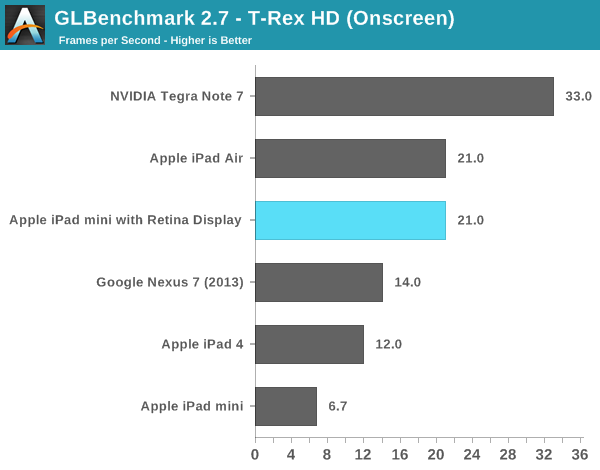

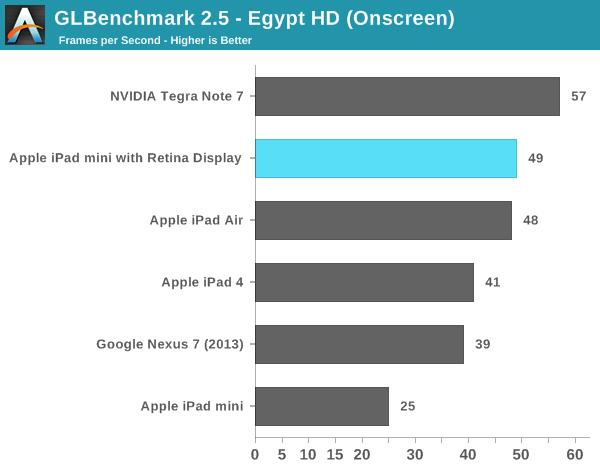
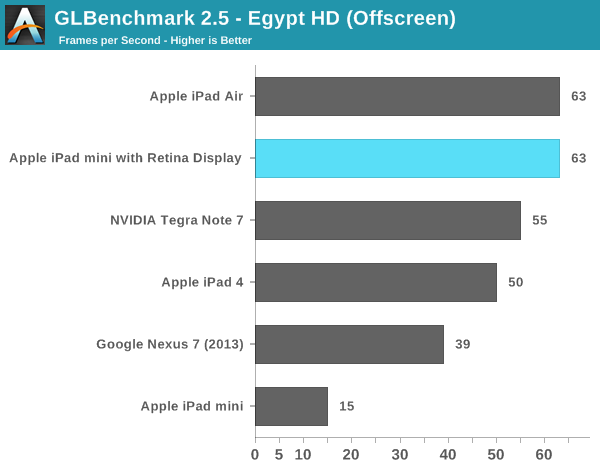
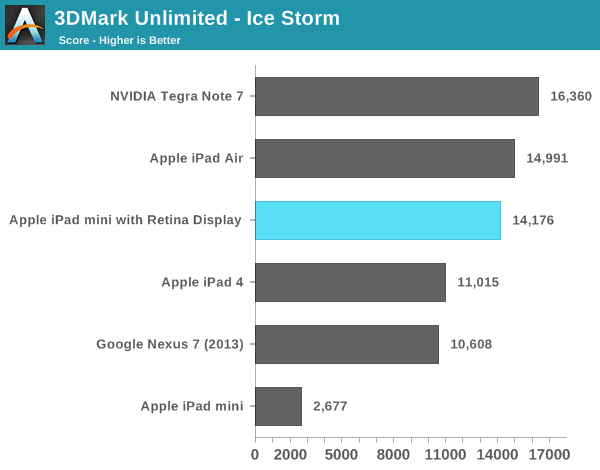
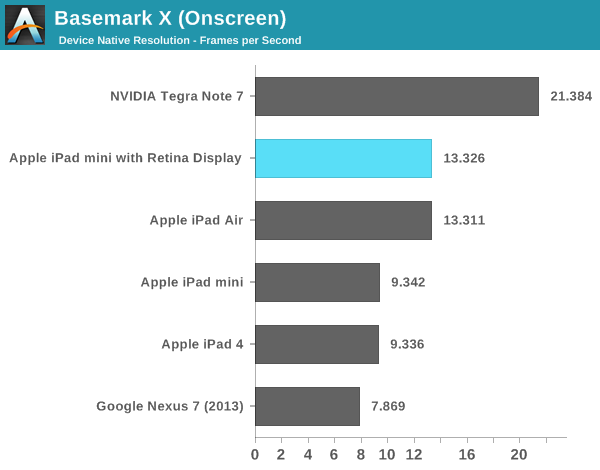
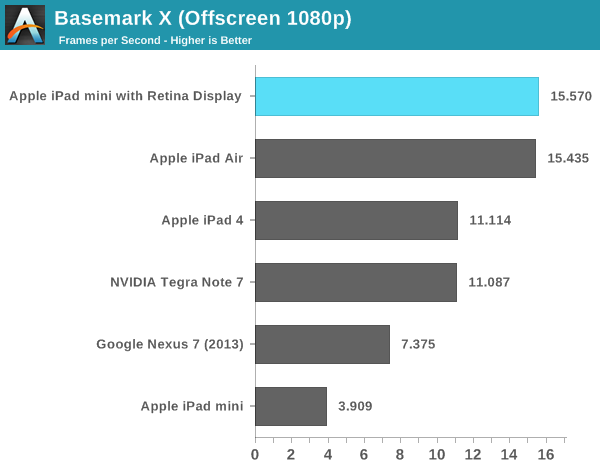
As I mentioned in our iPad Air review, despite having less peak theoretical memory bandwidth than the A5X/A6X, the A7 in the iPad mini never seems to regress in performance compared to even the iPad 4. Across the board the mini appears to be faster, more responsive and have more performance on tap than any prior iPad (big or small). The comparison to the original iPad mini is of course night and day. Even looking at lighter tests like the old GLBench Egypt HD benchmark, the iPad mini with Retina Display manages to be nearly twice as fast as the original mini - all while rendering 4x the number of pixels.


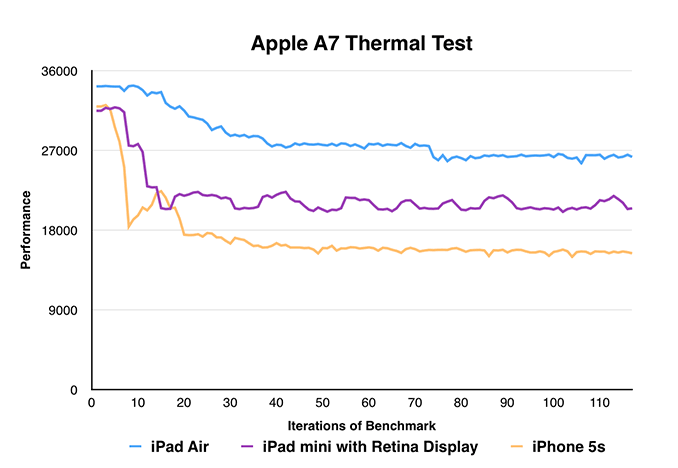
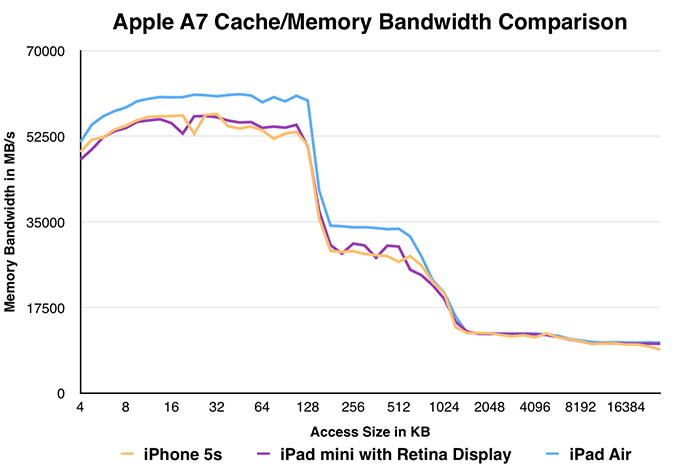








345 Comments
View All Comments
Jamezrp - Sunday, November 17, 2013 - link
I jumped to the iPad Air from the iPad 4, and have the iPad mini. After reading this, I'm pretty sure that I'll return the Air and not upgrade the mini either. Both have completely different use cases, and frankly, if I have the iPhone 5s (which I do), there's no reason to have all 3.That said, iPhone 5 owners are probably going to love the mini w/Retina. It's a perfect fit: no need to upgrade to the 5s, a significant power upgrade, and no loss of performance. I'd opt for the fullsize Air/4 because I use my iPad as a laptop replacement, though the mini is superior for holding one-handed. As Anand pointed out in this and the Air review, the larger tablet is still a tad too heavy to read on comfortably. The mini is not.
But if you've got the last-gen mini and use it mostly for reading and light web-browsing, no reason to upgrade. But the choice between the two is a no-brainer.
postitnowfool - Monday, November 18, 2013 - link
For the love of god post the nexus 5 review. Its been weeks and your posting this instead? Its the same dang thing as ipad air with smaller batter and screen. Doesnt take days and page and pages of stuff to figure that out. Who's working on it? Anand? Brian? Did you decide to skip it totally?psyside1 - Monday, November 18, 2013 - link
Yep, i said the same, this is the reason why N5 review is so late.Samuel Lord - Monday, November 18, 2013 - link
You said: "Small text is always easier to read when it’s on a larger display, but if you’re looking at content that’s properly formatted for a tablet you’ll be in good shape on the mini. I was asked to look into the comic reading experience on the mini and also came away pretty pleased. Text bubbles were definitely not as easy to read as on the iPad Air..."What a ridiculous standard! Are you such a slave to Apple products that you can't criticise their pitiable UI? Good Phones, tablets, notebooks, and PCs have this thing called WORD WRAP, where you adjust font size for your eyes, not for some twentysomething's idea of style. Need proof? FACT: Todays Macbook Air and all iPADs have a MAXIMUM text size (and only available on some Apple software!) that is smaller than the STANDARD text size on a 30-year-old, 9-inch screen macintosh computer. This is the result of Apple putting nitwits in charge of user interfaces. UIs used to be the crown jewels of Apple products, but now the commonsense approach taken by competitors has cost Apple billions in sales. Elegance will never trump functionality in the long run.
deasys - Monday, November 18, 2013 - link
FACT: Today's MacBook Air and all iPads have no limit on text size. WTH are you talking about?Samuel Lord - Tuesday, November 19, 2013 - link
Do a search for "Zoom Text Only." In a Win 7 machine (hey they suck, but for this feature) you just have ""zoom text only" in the Zoom button of the View menu. Then whenever you push Ctrl+ the text gets bigger, Ctrl- for smaller, as much as you want *without* changing the column widths. No unneeded scrolling! This is how computers should allow you to work: customize for *your* needs, not somebody's idea of *their* needs. Neither iOS Macs nor iPads nor iPad Minis have this feature. Zoom alone, without text re-wrap, is useless for browsing and countless other tasks. Some Apple software allows increasing default text size to 56 pixels...which sounds like a lot but is still much smaller than normal text.deasys - Tuesday, November 19, 2013 - link
Why comment on something you clearly have no knowledge of?Safari has long supported the exact functionality you note. Pull down its View menu and have a ball! And iOS devices have always supported double-tap zooming.
emoemeka - Wednesday, November 20, 2013 - link
You have obviously never used an iOS device because your comment is just ignorant.Samuel Lord - Thursday, November 21, 2013 - link
deasys, thank you. I have been trying for weeks in the Accessibility section of Sys Prefs trying different zoom settings, including maximum and using the Command+- tools, but never got intra-column zoom until now. Total zoom of a window happened, but the columns weren't static. Very strange. I was about to install win 7 with Bootcamp on my MBA just to allow my eyes to rest and to retire my Lenovo. This stuff happens a lot to me, I'll follow every step getting the unexplainable result, then it starts working. But yes, I know all of the text size settings not only in iOS but in 3rd party software. So yes, it works on 10.9, but iOS 7 still does not support text-only zoom.emoemeka, I expect I have put more time on various computers than you've ever seen. Apple did not make their zoom functions clear or simple to use. You might recall that default max and min zooms on the MBA (early 2013, now OS 10.9) are zero and zero. Really helpful, that. And as stated above, text-only zoom does not exist on the iPad for any app I've used with it. Presumably the iPhone and books on iPads are presented better, even Kindle got that right.
kwrzesien - Monday, November 18, 2013 - link
(+$100 for each increase in storage level, ugh)...there, fixed that for you.